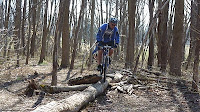Post shamelessly excerpted from the
Institute of Altitude Medicine website. Thank you IAM.
--------------------
An overnight stay at an intermediate altitude such as Denver (5280 ft) or preferably a bit higher prior to further ascent into the mountains is very helpful.
Staying hydrated is important as it aids your body in acclimatizing.
Avoid use of alcohol or sleeping agents of the benzodiazepine family, since they both suppress breathing and result in lower blood oxygen. Other sleeping pills like Ambien or Lunesta do not affect breathing at high altitude and are safe. Avoid over-exertion for 1-2 days after arrival to altitude.
[MO7S commentary: I prefer the word "moderation" to "avoidance." I use avoidance with influenza and mean people. In all other matters I think moderation is a better alternative]
Acetazolamide (Diamox®) taken 24 hours prior to arrival to altitude and the first 2 days at altitude is 75% effective in preventing AMS. It speeds up the acclimatization process in the body, stimulates breathing, raises blood oxygen and increases urination.
[MO7S commentary: ...and possibly improves tolerance for alcohol.]
Gingko biloba, according to some studies was effective in preventing AMS when started 5 days prior to ascending to altitude, at a dose of 100 mg twice a day.
Avoiding exposure to viral illness such as coughs and colds will improve your chances of staying healthy.
[MO7S commentary: See! I told you!]
When traveling consider wearing a mask if exposed to someone with a severe cough. Use proper hand washing and good hygiene to avoid transferring germs.
Altitude Myths
Myth # 1 - Don't drink caffeine at altitude.
We don't know where this false assumption came from, but likely from the fact that caffeine is a mild diuretic (makes you pee). The concern is that it could dehydrate you and contribute to altitude sickness. This concern is unfounded unless you drink pots of black sludge coffee a day and little else. In reality, caffeine stimulates your brain, kidneys and breathing, all of which are helpful at altitude. And for those people who drink several caffeinated beverages a day, stopping abruptly can cause a profound headache. See Dr. Hackett's article on caffeine and altitude.
[MO7S commentary: Thank you, thank you, thank you!]
Myth #2 - Diamox masks symptoms of altitude sickness.
Taking Diamox to prevent AMS will not mask symptoms. It works on the same pathway that your own body uses to help you acclimatize. It is a carbonic anhydrase inhibitor which makes you urinate a base chemical called bicarbonate. This makes your blood more acidic and therefore stimulates breathing thereby taking in more oxygen. It speeds up your natural process of acclimatization and if you stop taking it you will not have rebound symptoms. It is one of the main medicines doctors use to prevent and treat acute mountain sickness (AMS).
Myth #3 - Physical fitness protects against altitude sickness.
Physical fitness offers no protection from altitude illness. In fact, many young fit athletes drive themselves too hard at altitude prior to acclimatizing thinking they can push through the discomfort. They ignore signs of altitude illness thinking it can't affect them because they are fit and healthy. Everyone, regardless of fitness, is susceptible to AMS.
Myth #4 - Drinking extra water will protect you from altitude illness.
Staying hydrated is important at altitude. Symptoms of dehydration are similar to AMS. In reality you only need an additional liter to a liter and a half of water at altitude. Too much water is harmful and can dilute your body's sodium levels (hyponatremia) causing weakness, confusion, seizures, and coma. A good rule of thumb to assess for hydration is to check your urine. Clear urine indicates adequate hydration, dark urine suggest dehydration and the need to drink more water.
Myth # 5 - Children are more susceptible to altitude illness.
Several studies have shown that children have similar rates of altitude illness as adults. No evidence exist that children are more susceptible to the altitude. If your child is otherwise healthy and the basic rules of acclimatization are followed they will likely do well at altitude. Children do get altitude illness and the main challenge in those very young is that they can't communicate their headache and other symptoms. Excessive crying in a baby the first 1-2 days at altitude could be altitude illness. Children with AMS bounce back quickly with treatment as do most adults.







